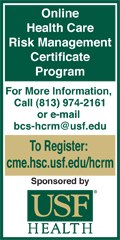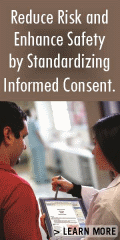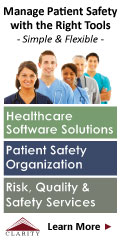 |
 |
 |
|
 |
 |
 |

November / December 2005

Patients
How Safe do Patients Feel?: Sidebar
Communicating With Patients
- Recognize and compensate for different degrees of patient literacy.

- Provide information to guide patients throughout the entire experience including brochures and/or videos that walk through the entire care process for specific clinical conditions.

- Provide an explanation before it is requested.

- Provide explanations before touching or moving the patient during tests or
treatments.

- Make explanations easy to understand.
- Information should be tailored to the patient's needs and circumstances.

- Information should be given in a variety of forms and reinforced over time.
- Provide information about delays.
- Give more information than you believe is necessary. Patients usually want to know more than caregivers think, particularly about risks and safety issues.

- A picture is worth....Use diagrams and drawings, since different patients learn using different modalities. Some do better with the spoken word, some, with visual media.

- Listen up. To get your message across, you need to understand the concerns of the patient. This can only be achieved after careful attention to what the patient is saying, and how s/he is saying it.
- Get started by confirming the medical facts and deciding what needs to be said; prepare for emotional responses.

- Determine what is already known by the patient and family.

- Find out how much more the patient and family want to know.

- State the bad news compassionately yet directly. Then pause and let the news settle.

- Be prepared for sudden, strong emotional reactions, and respond to patient and family feelings, such as sadness, anger, love, relief. Support them by saying something like, "I know this is not the news you wanted to hear; can you tell me what you are feeling right now?"

- Planning, follow-up: What happens next? It may be further diagnostic work, a therapeutic intervention, or gathering additional support.
- Provide patients, staff, and physicians confidential contacts to disclose medical errors. Assure staff and physicians that nothing reported through those lines will be used for legal action.

- Create trained medical error disclosure teams and provide assistance to any provider wishing to disclose a medical error.

- Make trained legal experts and patient liaisons a part of medical error disclosure teams to make sure both sides are fairly represented.

- Train staff on all polices and procedures for reporting medical errors at least once a year.

- Allow families to be part of the corrective action process.

- Reserve loss of privileges and/or firing of physicians/staff for medical errors resulting from gross negligence and/or malicious intent.

- All staff involved in the medical error should participate in the corrective action process.

- Individual institutions must support staff involved with medical errors before an industry-wide culture of transparency will develop.
- Disclose the error

- Tell why it happened

- State how the error's effects will be moderated

- State how the error will be prevented from happening again

- Apologize for the error 2
- Standardize the procedure and identify its steps.

- Discover the patient's experience through structured interviews with patients about the salient aspects of their thoughts and feelings going through the procedure.

- Validate through a second set of interviews; this assures that the key experiences are applicable widely.

- Write the message by combining the information into a coherent package, including the procedural steps, physical sensations experienced (and explanations for them), and their sequence and duration.
- Organizes disease-specific information.

- Provides an area for patients and family to log questions, symptoms, medication side effects, nutritional support, etc.

- Roles of staff are clearly defined.

- Physicians have a bio page.

- "Contacts and Appointments" section is provided to keep track of the time and place of all appointments.
- Medical error disclosure is one of the most complicated information exchanges in the patient-provider relationship. Current tort law for most of the United States equates an apology with an admission of guilt, exposing providers and organizations to malpractice risk. Given the current legal environment and the overall resistance to medical error disclosure, institutions desiring to create a culture of safety are obligated to develop systems for medical error disclosure that balances both parties' interest.

- It is important to discuss with your legal department and medical ethics committee the proper way to apologize without exposing yourself or the institution to additional malpractice risk.
- Return to main story:

|
 |
 |
 |




















|
 |
| |
|
|
|
|



